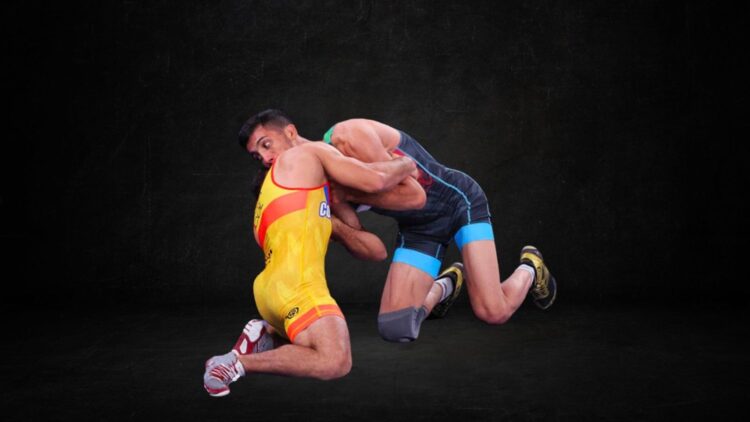
OBJECTIVE OF GRECO-ROMAN WRESTLING: Successfully pin the opponent’s shoulder blades to the ground for at least two seconds or accumulate the most points by the end of the match
NUMBER OF PLAYERS: 2 players
MATERIALS: Singlet, ear guards, knee pads, mouthguard, wrestling shoes
TYPE OF GAME: Sport
AUDIENCE: 4+
OVERVIEW OF GRECO-ROMAN WRESTLING
Greco-Roman wrestling is an Olympic wrestling discipline that is very similar to freestyle wrestling. Unlike freestyle wrestling, however, Greco-Roman wrestling forbids any grabs below the waist, turning the sport into one that emphasizes throws as the primary form of takedown.
Historically, Greco-Roman wrestling is considered the modern interpretation of the style of wrestling that developed in Ancient Greece. However, there is little evidence to suggest that modern Greco-Roman wrestling is anything like ancient forms of wrestling. In fact, the rule concerning not holding the lower body was only implemented in the 19th century.
Despite its popularity in Europe, Greco-Roman wrestling struggled to gain traction in the United States for a long time. This was mainly due to the fact that many people thought freestyle wrestling to be more appealing, considering its fewer restrictions and rules. Despite this, the Olympic Games first featured Greco-Roman wrestling in 1896, whereas freestyle wrestling wouldn’t make an Olympic appearance until 1904.
SETUP

EQUIPMENT
- Singlet: A traditional one-piece uniform. Singlets are tight-fitting and often made of spandex or nylon.
- Ear Guards: Headgear that provides ample protection to both of a wrestler’s ears. A lack of ear protection can lead to “cauliflower ear”.
- Knee Pads: Competitors whose wrestling style involves them sliding around on the ground a lot utilize knee pads. Since Greco-Roman wrestling doesn’t allow below-the-waist holds, these are rarely worn by wrestlers of this style.
- Mouthguard: A general safety precaution taken to protect the teeth and mouth.
- Wrestling Shoes: High-top shoes designed to provide the wrestler with extra traction and ankle support. These are often meant to be as minimally intrusive as possible, meaning they are incredibly light and flexible.
COMPETITION FORMAT
Greco-Roman wrestling matches consist of two three-minute halves with a thirty-second break in between. These matches are usually part of tournaments that separate wrestlers into different brackets based on weight class.
These tournaments are usually in a single-elimination format, with the winner of each match going on to face the winner of another match until there are only two finalists left. On top of that, Greco-Roman wrestling also uses a repechage system. These are additional rounds in which the wrestlers who lost to the two finalists can verse each other to decide who gets the bronze medal.
THE REPECHAGE ROUND
The wrestler who lost to one of the finalists in the first round of the tournament will face off against the wrestler who lost to the same finalist in the next round. Then, the winner of that matchup goes on to face the wrestler who lost to that same finalist in the following round, etc.
On the other side of the bracket, all of the wrestlers who lost to the other finalist face each other in the same format. Eventually, two bronze medals are awarded to the respective winners of the repechage round.
GAMEPLAY
SCORING
In Greco-Roman wrestling, points are scored the same way as in freestyle wrestling, with more points awarded for moves that either carry more risk or appear more “grand”. These include:
- Takedown (2-5 points): This is a move where the opponent is brought to the ground in a way that the wrestler is able to take control of them. Higher points are awarded for throws of “great amplitude”, in which the opponent is in a position of immediate danger. On the other hand, fewer points are awarded if the wrestler manages to bring the opponent to the ground but not on their back and not in a position of immediate danger.
- Reversal (1 point): A point is awarded when a wrestler in a defensive position manages to reverse their position and gain an advantage over their opponent.
- Near Fall (2-3 points): Also known as “exposure”, near falls are when a wrestler almost manages to pin their opponent on their back and meets partial criteria for a pin. The wrestler wins more points according to how long the exposure is.
- Escape (1 point): One point for a wrestler escaping a defensive position on the ground and getting back on their feet.
- Penalties (1-2 points): As with most sports, minor infractions result in points being awarded to the offending wrestler’s opponent. Each penalty also comes with a “caution”. After a player accumulates three “cautions”, the opponent wins the match by forfeiture.
WIN CONDITIONS

Greco-Roman wrestling matches use the same win conditions as freestyle wrestling, albeit with a few minor differences. These include:
1. FALL
Also known as a “pin”, a competitor scores a “fall” when they pin both of their opponent’s shoulders or shoulder blades against the mat for at least two seconds. This is an immediate victory.
2. TECHNICAL SUPERIORITY
If a wrestler amasses eight or more points than their opponent at any point during the match, that wrestler wins by technical superiority.
3. DECISION
If no other win condition is met, the wrestler with the higher point total wins. If the wrestlers are tied in points, this decision is based on how many penalties each wrestler accumulated, the “value” of the points (higher-scoring moves are considered more valuable), and which wrestler scored the last technical point. Oftentimes, the wrestler who scored the last technical point wins by decision.
4. DEFAULT
This is a victory that comes from an opponent’s forfeiture or withdrawal from a match. This also includes if they never show up to the match at all.
5. INJURY
A wrestler can win a match if their opponent becomes too injured to continue. This includes if the opponent takes too many injury timeouts or is bleeding too much. However, on the flip side, an injury resulting from an illegal or dangerous maneuver disqualifies the offending wrestler.
6. DISQUALIFICATION
The referee will disqualify a wrestler if they accumulate three cautions in a match or commit flagrant misconduct. This results in the opponent winning the match.
RULES
Greco-Roman wrestling shares many of the same rules as freestyle wrestling. Each infraction carries with it a one- or two-point penalty that is awarded to the opponent. These rules forbid the following:
- Calling an injury timeout (except in the case of bleeding)
- Intentionally striking the opponent
- Using moves with the intent to injure the opponent
- Using illegal holds*
- Using the legs to trip the opponent
- Purposefully going out of bounds
- Grabbing the opponent’s clothing
- Passivity**
- Flagrant misconduct (immediate ejection)
*Unique to Greco-Roman wrestling, any hold beneath the waist is considered illegal. This rule is pivotal to the identity of this wrestling style.
**Also unique to Greco-Roman wrestling is how passivity penalties work. These penalties carry no warning and instantly reward the opponent (non-passive wrestler) with a point. The opponent also gets the choice to place their opponent into a standing or “par terre position” with their stomach on the ground. The non-passive player also gets to place them into any hold they want in this position before resuming play.
A UNIQUE STYLE OF WRESTLING
Greco-Roman wrestling shares many similarities with freestyle wrestling—both enforce the majority of the same rules, use the same scoring system, and decide matches based on the same criteria. However, due to the single rule that outlaws any holds or grabs below the waist in the Greco-Roman style, the two wrestling disciplines play very differently.
With all holds occurring above the waist and the use of the legs being disallowed, Greco-Roman wrestlers must find ways to explosively throw their opponent to the ground. In other forms of wrestling with no such limitations, it is rare to see takedowns that don’t involve the lower body. In many ways, this emphasis on throwing techniques makes Greco-Roman wrestling appear more akin to judo than to freestyle wrestling.
END OF GAME
The wrestler that successfully pins their opponent’s shoulder blades to the mat for at least two seconds or accumulates the most points by the end of the match is deemed the winner.
- 30 GAMES TO PLAY OVER TEXT - April 22, 2024
- 20+ FREE PRINTABLE BABY SHOWER GAMES - April 16, 2024
- 20+ College Party Games for the Best Night Ever! - April 2, 2024